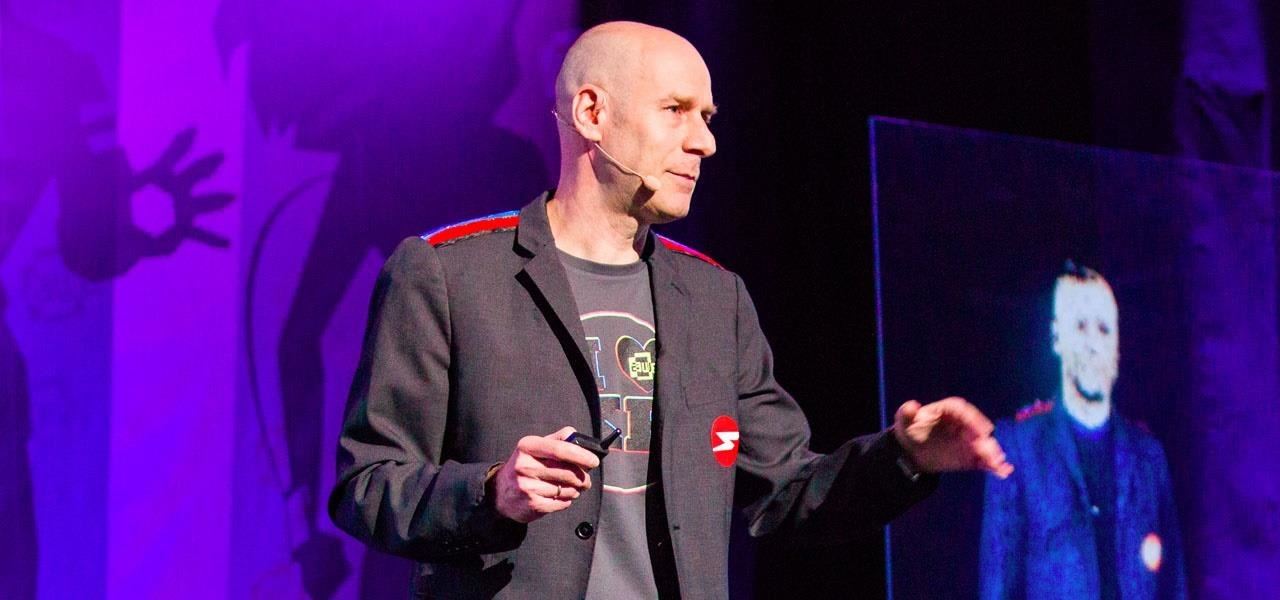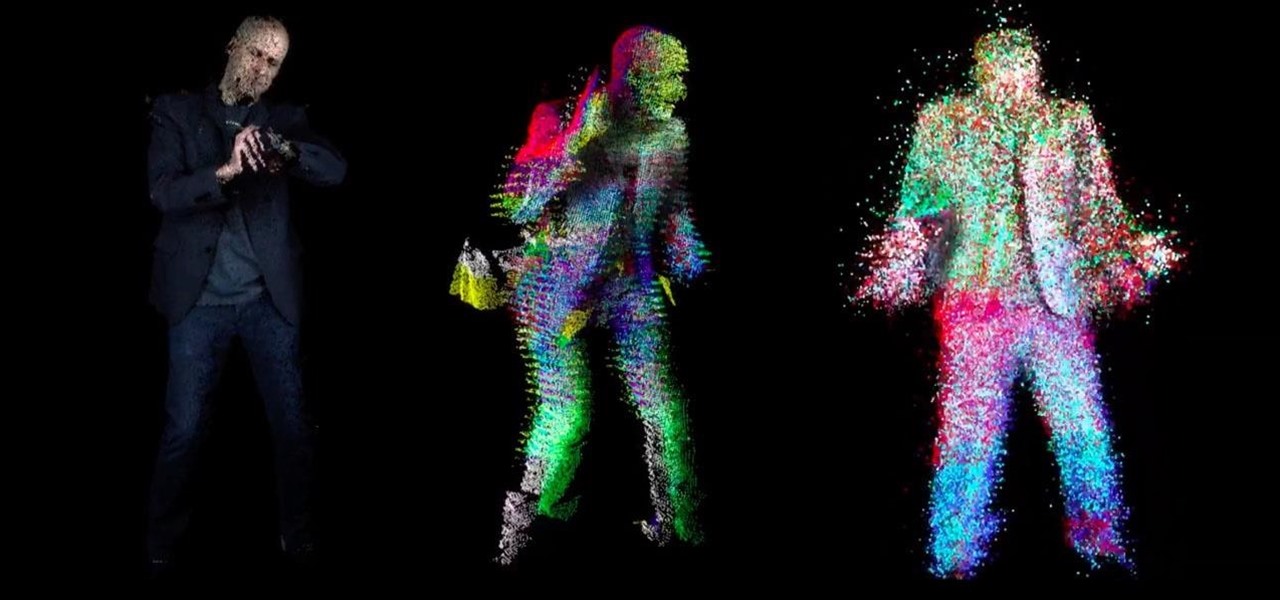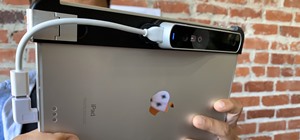In just a few weeks, on May 29, the annual AWE (Augmented World Expo) conference will take place once again in Silicon Valley (Santa Clara, California, to be exact).
And while everyone will be on the lookout for the next big thing in augmented reality coming from major players and small startups alike, now, on the possible eve the dawn of Apple's AR wearables, is the perfect time to take a reflective look the best known AR gathering in the industry.
To that end, I managed to get AWE founder Ori Inbar (also the founder and managing partner at investment firm Super Ventures) to me about keeping the AR flame alive for him and the event for nearly a decade.
We covered a wide range of issues, including what's changed about the AR space, what needs to change, and what we both see coming up on the AR horizon.
Adario Strange: So, for the uninitiated, give us a quick primer of how AWE got started and what your background is.
Ori Inbar: This is the tenth year. Our first event was in June 2010, very early in the AR industry days. A couple of hundred of people in the industry got together. There was no other event at the time, and back then we talked about ideas, concepts, and vision. And since then, the event has grown to be the largest of its kind with 7,000 attendees, 250 exhibitors, and people showing real products and real adoption, from enterprise to consumer, across the entire ecosystem.
I started an AR company back in 2009; it was called Ogmento. It was a very lonely experience. There were very few people out there that even knew what AR meant. So I joined forces with a few other players in the industry, and we formed AWE. Actually, the first year it was called ARE (Augmented Reality Event). A couple of years later, we changed it to AWE. It was actually in the same location, in Santa Clara, California, but we took a very small space compared to what we have this year.
Strange: OK, so that's the start, but who works with you on it today? I know Tom Emrich joined several years ago to help co-produce the event, but who else is involved?
Inbar: We have an organization called AugmentedReality.org that we founded to help do the event, as well as accelerate other activities in this industry. We set up a goal of 1 billion AR users by 2020. The event is now running in the US, Europe, Asia, and Tel Aviv Israel since last year. We also now have 10 monthly meetups, in 10 cities around the world, many of them in the US, Toronto, Berlin, and Tokyo.
The organization is basically me, along with a board helping support it. They are all entrepreneurs in the AR industry. And we work with a couple of groups that help produce the event. Prospera Events, mostly focused on the logistics, has been helping us with the event since 2010, and we now have a couple of other groups that are helping with programming, sales, and the audio-visual aspect of it.
Strange: When a traditional company mentions a specific target number of users, it's usually tied to one particular platform or product. So what does it mean, in practical terms, when you mention the goal of 1 billion AR users by 2020? Where do you envision these 1 billion users coming from?
Inbar: That was almost 10 years ago. We didn't know what devices people would use, so it was just kind of a moonshot, a rallying cry, to help us find a goal. It turned out, as the industry has advanced, most of it will be on smartphones, but also on smartglasses, projectors, and what we call magic mirror experiences.
Strange: That makes me think of Facebook's publicly stated goal of 1 billion users in VR. Which do you think will reach 1 billion users first, AR or VR? Although VR is enjoying a lot of the public attention and excitement related to gaming right now, I bet that AR will reach that number first, but what do you think?
Inbar: It's 2019, so we're just a year away from that goal, and I think it's pretty clear that the majority of that audience is on smartphones. Because there are already 3 billion smartphone users out there, and most of them are AR-enabled. So all you need is build an application for those devices and get people to use it. I think we're actually getting pretty close to that number.
On VR, today it's around 10 to 20 million devices. And the growth is expected to go faster, maybe 30 to 40% year-over-year. So VR is going to grow, and it's going to be great, but it's not going to match the numbers that we can have on smartphones.
Strange: In my research and reporting on VR and AR, I often find that people generally gravitate toward one or the other rather than voraciously engaging in both consistently. I started with a heavy focus on VR, but have gradually balanced my immersive computing usage to around 50-50, AR and VR. What's your daily breakdown like?
Inbar: On average, during a full day, I spent about an hour in VR in the evening at home, but I use AR throughout the day, whether it's in the office, or outdoors, where I want to stay in reality, but I want to enhance it. And I think that will become pretty typical when you apply that question to the rest of the world, where people use AR throughout the day to remain in the workplace and collaborate with other people in reality. And then, when they get home, instead of sitting in front of the TV, they will immerse themselves in VR experiences that they cannot do otherwise.
Strange: We recently published a series of posts talking about the future of augmented reality. In one section I talk about the differences between AR and VR and why we should look at them as two distinct and mostly separate areas in terms of use cases.
In that area, one somewhat annoying topic that keeps coming up is this idea of a hybrid device that will combine both technologies into one product. But when I hear that, for me, what always comes to mind is a hovercraft. I mean, sure, we can make a vehicle that travels on both land and water, but that doesn't mean that it's the most practical device to devote time and attention to in terms of hybrid use cases. My thinking is that, at least in the short term, A hybrid VR/AR device is an impractical approach. But I think a lot of people are hoping for a hybrid device so it will be easier to sell various VR and AR solutions and platforms.
Perhaps in 15 years, when everything has gotten smaller in terms of components, and form factors have changed, the technology will make this more feasible, but right now, let's say, the next decade, it just seems like the wrong approach. What do you think?

Inbar: I totally agree. I think right now it's almost a waste of time to talk about a hybrid device because it's not relevant. It's two different devices and two different use cases. But like you said, sometime in the future, 15, 20, 50 years, I imagine a point where you could open your eyes to do AR, and close your eyes to do VR.
Strange: Last year's AWE event was a pretty good representation of established industry players as well as fresh startups in the AR space. But while I've been attending a wide range of tech conferences for many years, I've just started coming to AWE events, so my perspective is likely very different from yours. Give me a sense of how the event has changed through the lens of yourself as the founder over the past decade.
Inbar: In the beginning, it was just the enthusiasts. But now it's a completely different world. I look back at the companies and the people who attended the first event, and it's interesting that there were a few enterprise and Fortune 1000 companies. Like Boeing and Lockheed Martin, they were some of the first pioneers to try AR and VR, so they were there in the first year to kind of check out what was going on.
But now I think, in the last couple of years, the big change you see, because of a lot of the ROI studies that are showing significant uses for businesses, there's a massive number of businesses that go into this event to really check out the latest solutions whether it's small glasses that are targeting the enterprise, or software solutions that are targeting the enterprise — warehouse picking, remote service assistance — all these kind of use cases that are much more mature than what you saw in the past.
What we hear from exhibitors is that they go to CES because it's mandatory, and they go to Mobile World Congress because it is such a big event. But when they go to AWE, one hundred percent of the audience is relevant to them, whether as customers, or partners, to hire, or just people to get inspired by.
Strange: That leads into something else I wanted to get into, which is something we think about a lot here at Next Reality. Right now, we're still looking at AR as edge technology, but within the next five years, with the advent of Apple's rumored AR smartglasses, as well as other solutions, AR and the software that drives it will become far more mainstream. At that point, conferences like CES and others will begin to double down on their interaction with AR as an industry. What do you do then?
Inbar: That's a great question that we're starting to think about. I got into this not to be in the event business. I'm an entrepreneur. My goal, my passion, is to see this industry become mainstream. So in essence, once it becomes mainstream, you could say our job is done. But there will still be a need to innovate and guide the industry toward the potential of the spatial computing industry. I think it's probably like a 10-year journey from today.
Strange: Yeah, that reminds me of what happened to the Macworld conference. Once Apple began to hold its own events, it seemed like the Macworld conference began to wither rather than innovate on what it was doing. Of course, that's a shorthand way of looking at it, there are other factors involved, but I don't think it necessarily needed to disappear. So I guess that's the overall approach for both of us, which is to evolve as the space evolves into the mainstream.
Inbar: Exactly. I think there's always room for innovation, especially with spatial computing where we're in the very early stages. We have to develop a new visual approach that I don't think we have yet. What does it mean to interact in a world where everything is visual and around you, and not on a two-dimensional screen? So there's a lot to do there.
Strange: Staying on the topic of conferences, I've had a few discussions with women in the immersive computing space about how things look in terms of representation at VR conferences versus AR events. From my vantage point, it appears that I meet more women in positions of leadership and the spotlight at VR events (founders, developers, enthusiasts, etc.), but it seems less so at strictly AR events.
Initially, I thought this was perhaps just my take, but some of the discussions I've had with women in tech have echoed my admittedly unscientific assessment of the two spaces. I did notice when I went to AWE last year, it felt like a very normal tech conference in that it appeared to involve more men at the event than women. So I'm wondering if you agree or disagree with this perception, and if you agree, can you discuss what your team doing to perhaps help to change that dynamic.
Inbar: I'm really glad you brought this up. This actually has been a very important topic for us. I can't comment about the other events, but in our events, we put a lot of emphasis on getting women on stage. I would argue that we probably have the highest ratio of women versus men compared to other large [tech] events. If you go through our speaker list, it's probably around 40% [women speakers], which is incomparable to any other conference of this size. The partnership that we've done with Women in XR and the WXR Fund, and other women-focused organizations in XR, has proven to be very beneficial to that end.
In terms of the audience, it's still skewed a bit toward men, but I think not as much as you see at other big tech conferences.
- Don't Miss: The Rise & Fall of Meta — Founder of AR Pioneer Reveals Inside Story That Led to Its Sale to New Owners
Strange: How do you think this is all going to shake out in the next four to five years in terms of the high-end AR headset makers versus these somewhat lower-tier devices like the Nreal Light, or if it does become a reality, the Apple smartglasses?
Inbar: There's probably 50 manufacturers of smartglasses right now, not even counting VR headsets. Some of them went out of business last year, as you know. The new ones come out, like Nreal, Rokid, and a few others, which I think is pretty typical of this stage in the industry. And many investors and critics say, "How can a small company compete with Apple or Google?" But you could even say that about Magic Leap. It's very well funded, but it's still small compared to some of the big players, so "how can they compete?"
I think that we've seen in any tech cycle that, yes, the big players have an advantage but, in many cases, they're not actually able to make the transition to the next cycle. So then you have new companies emerging and taking over. I think that definitely could happen now, even though smartglasses seem like a very hard problem to solve. I definitely see some of the small players succeeding in at least taking a niche and running with it.
What Qualcomm did to Intel in the mobile chip space is something nobody predicted. How come Intel couldn't take over chips for mobile devices? And I think now we could see the same thing [in the AR space]. A few companies are building next-generation displays for smartglasses. Some of them are still in stealth mode, and they could become the equivalent of Qualcomm, where everyone, whether it's Apple or Google or others, will use their displays because they are the best and the smallest.
Strange: We recently published a story about the AR cloud and the issue of trust and privacy as we move forward in the AR space. Part of the the problem may relate to trusting your AR cloud data with a foreign company, in some cases, from China, which has been in the news lately with regard to user privacy via Huawei, or just allowing your movements and what you see through smartglasses to be tracked by "any" company. Remember, this isn't only a foreign AR startup concern, it also speaks to some of the issues in play at Facebook, which is yet another company working on releasing an AR wearable. Do you spend much time thinking about that on your side?
Inbar: First of all, regarding the Chinese market, you've probably seen the Digi-Capital report that forecast that the Chinese market will be the biggest market in the world for AR hardware and software, just for the sheer size of the country. So that's definitely something that no one can ignore. We went with AWE to China in 2016 to get to know the market; we couldn't ignore it.
On the issue of trust and privacy, I think what we see today is just a hint of what will come in the future. In spatial computing, when you have a camera pointing out everything you do, and analyzing it, those concerns will be one million times bigger than they are today. Talking about the AR cloud, I can't see any American people using AR clouds managed by China, and vice versa.
Strange: But what if they don't know that a Chinese company manages the AR cloud they're using? As I found in my past reporting, specifically concerning hoverboard manufacturers, in many cases, Chinese companies operated using a United States address, and an English name, but were based in China. But many US consumers assumed that the sometimes dangerous products they were purchasing were US-based, with the same accountability as any other US-based company. As AR smartglasses get cheaper and more widespread in terms of brands coming from various manufacturers, I see this becoming a potential issue for the AR space as well when it comes to AR cloud data.
Inbar: That would be a problem. But it's kind of like Huawei, most people in the US didn't know about its alleged practices, and now they know, and now there's this backlash. I think it's going to be your job and my job to make sure that we uncover these kinds of things so that consumers are well informed of what they're using, especially when privacy become such a huge topic in those cases.
Strange: On the topic of trust, you guys run one of the biggest immersive computing conferences out there, but you also have this major AR investment fund. It seems like there might be a lot of opportunity for potential conflicts of interest regarding who gets access to what, and who is represented in what way. Do you get questions about that?
Inbar: It's a fair question. And we've tackled this question since we started. Legally, there are two different organizations: there is the nonprofit that does the event, and the VC organization that does the investments. But at the end of the day, it's all in the people. And if you follow some of my work over the past 12 years, I've been advising and helping thousands of AR startups for free, for the love of the game, and been connecting them and helping them, whether it's in AWE or beyond. In our minds, we have a very hard wall between what we do to keep growing the community, and helping drive adoption of AR as an industry versus what we do on the investment side.
So of course, with our portfolio companies, we spend a bit more time, but we make sure that no confidential information passes from one side to the other. I think if you talk to companies either at the event, in our communities, as well as in our portfolio, I think you'll see there's a very strong support of these ethics.
Strange: I recently had the opportunity to use the HoloLens 2, and it changed my opinion of the company's efforts completely. I was not a fan of the first device (HoloLens 1) in any way, from the fit to the experience. But the HoloLens 2 might be my favorite device from Microsoft next to the Xbox. But it's still being framed as an enterprise device, so it's not likely to become a mainstream vector for AR becoming popularized. With that in mind, I'm wondering what you think the biggest hurdle is to AR exploding into the mainstream?
Inbar: Content. People understanding that there are certain things for which they will "have" to use smartglasses. That will generate demand for more. Companies like ODG and Meta, they've made their share of mistakes, but one of the main things is that to get to a smaller size and lower cost, you have to produce those devices in large numbers, in the millions. And until there's a demand for millions of those devices, there's no way we can get there.
I think we are now getting close to that. You see 100,000 unit order for the HoloLens 2 [via the US military], and we recently heard that RealWear got an order of 10,000 units from a utility company. So you're starting to see the numbers grow to a point where we could make the production of these devices much cheaper and allow for the miniaturization of the various components.
A big part of [mainstream adoption] is education. Until you get into AR and VR, you don't really know what you're missing. You can't really learn about it from videos. And that education takes time. So the education, plus the understanding of the need, will create a demand. That will allow the whole industry to get to a point where it's mature and produces the devices that we all want.
Also, it's about the display technology. Most of the devices today use waveguides, which have been great to bring us to where we are today. But you're not going to be able to make the leap to where we need to go in terms of miniaturizing the glasses and solving some of the big issues in the quality of the displays. I think it's pretty clear to me today; the next-generation technology involves retina projection, something that was invented in the early '90s. Magic Leap kind of built their big investment rounds on that idea, but haven't delivered on that.
Strange: Agreed. Back when I met with them at my New York office in 2015, that is the dynamic that was described to me to stir interest in the product and company. But it's not what they ultimately revealed. I think that's what's behind a lot of the negative media takes regarding the company in the last year after the debut of the Magic Leap One. I think the Magic Leap One is a perfectly fine device. It's just not what they promised early on.
Inbar: That [retinal projection] technology, we're starting to see the early stages of it with the North's Focals smartglasses. That's going to be necessary to really get to a form factor that looks like regular glasses — and overcome the issues of brightness and focus, and even occlusion — that, today, is almost not possible with waveguides.
Just updated your iPhone? You'll find new features for Podcasts, News, Books, and TV, as well as important security improvements and fresh wallpapers. Find out what's new and changed on your iPhone with the iOS 17.5 update.























Be the First to Comment
Share Your Thoughts